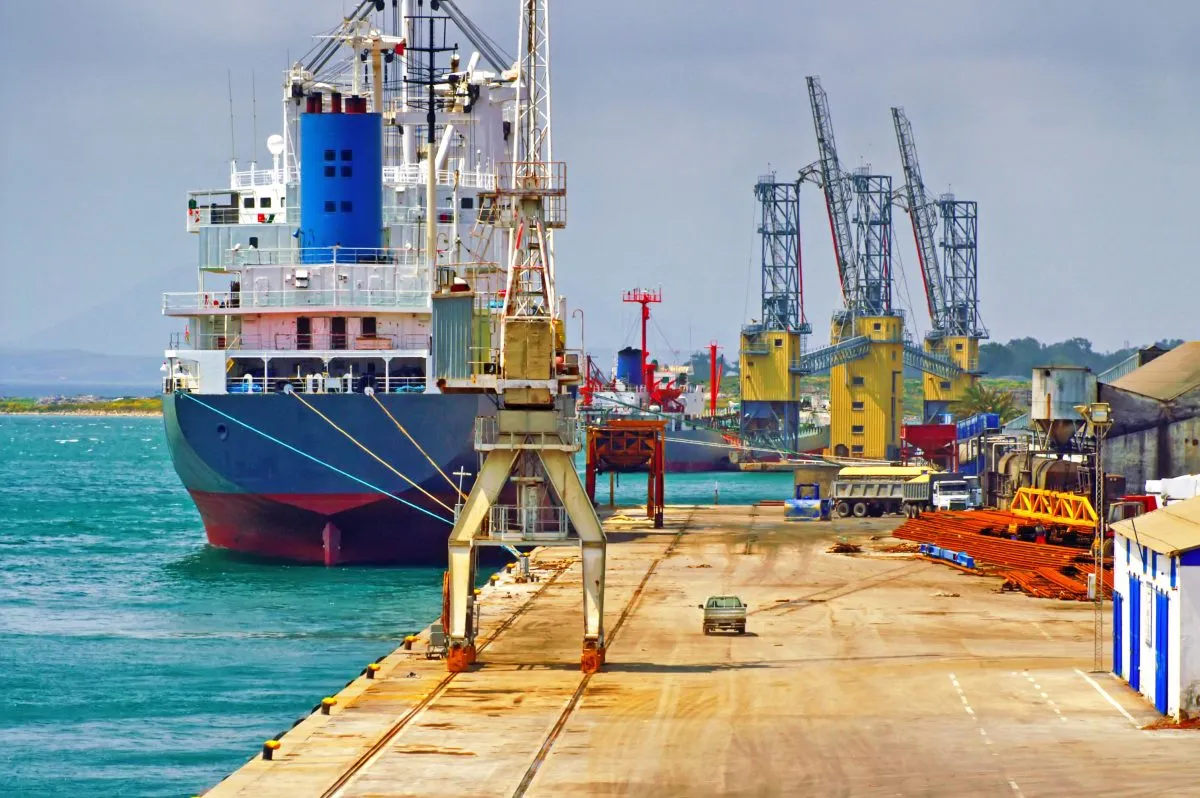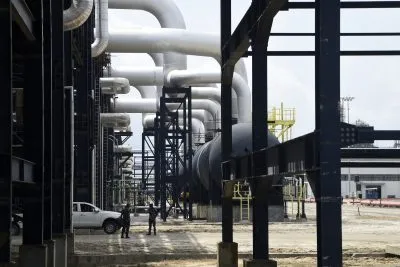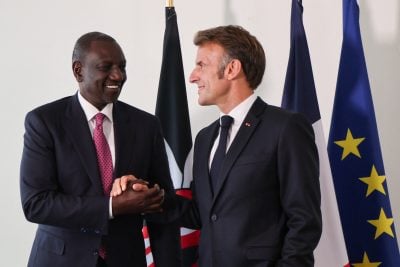Since colonial times, African trade has been dominated by the export of commodities to more developed countries outside the continent. Raw materials such as petroleum from Angola, lithium from the Democratic Republic of Congo and copper from Zambia are transformed into higher-value products in Europe, Asia and North America.
With limited possibilities to turn them into finished products, African countries lose out – cocoa producers such as Côte d’Ivoire and Ghana capture less than 7% of the value of the $120bn global chocolate industry. In 2021, Nigeria, one of Africa’s biggest exporters of crude oil, imported $11.3bn worth of refined petroleum products from countries such as the Netherlands and Belgium.
Meanwhile, trade between African countries is low. In 2017, trade with other African countries accounted for 16.6% of African countries’ total exports, while the comparative figure in Europe was 68.1%.
With trade going via sea to Europe, Asia and North America, the continent’s road and rail infrastructure has remained relatively underdeveloped, making intra-African trade both slow and expensive. In addition, trade integration across the African continent has long been limited by outdated border infrastructure, a patchwork of differing regulations across dozens of markets and trade barriers erected to defend industries against regional competition.
The African Continental Free Trade Area (AfCFTA) agreement is an ambitious trade pact that aims to transform this situation by turning Africa into the world’s largest free trade area. When fully implemented it will create a single market for goods and services for almost 1.3bn people across Africa, with a combined GDP of around $3.4 trillion.
Related articles
- How ambitious AfCFTA implementation can drive agricultural trade growth for Africa
- How can the US and Africa build on AGOA to boost trade relations?
- Regional value chains are key to Africa’s prosperity
The decision to work towards the creation of a continental market for goods and services was taken by the African Union in 2012. Negotiations for the AfCFTA began in 2015 and the agreement was signed by 44 of the African Union’s 55 member states in Kigali, Rwanda, on March 21, 2018. The only country still not to sign is Eritrea.
In the words of Wamkele Mene, the head of the AfCFTA Secretariat – the institution responsible for coordinating implementation of the agreement – the AfCFTA provides Africa with a “renewed opportunity to steer its economic relations away from a reliance on external donors, foreign creditors and excessive commodity dependence, ushering in a new economic era focused on self-reliant cooperation, deeper integration and higher levels of intra-African trade”.
In a 2020 report, the World Bank estimated that under the AfCFTA the volume of total exports would increase by almost 29% relative to business as usual by 2035. Intra-continental exports would increase by more than 81%, while exports to non-African countries would rise by 19%.
By May 2019, the number of states ratifying the treaty had passed the threshold of 20 required for it to enter into force; the number now stands at 47. However, while trading under the AfCFTA officially commenced on 1 January 2021, meaningful trade has only begun in eight countries (see below). Implementation is an ongoing process and it will be years before the AfCFTA reaches its full potential.
Many issues still to be resolved
AfCFTA negotiations have taken place in three phases. Phase 1 was completed with the ratification of the AfCFTA agreement, which was accompanied by protocols on trade in services and goods and settlement of disputes. This provided a basis for the commencement of free trade, but many details have yet to be resolved.
For example, states have undertaken to eliminate tariffs on 97% of goods and services produced by member states, with 90% to be eliminated in equal instalments over five years in the more advanced economies and 10 years in less developed economies. States must submit their proposed tariff reduction schedules for negotiation, but a number have yet to do so, including Africa’s largest economy, Nigeria.
Non-tariff barriers (NTBs) – barriers to trade that take a form other than tariffs or customs duties – are prohibited under the AfCFTA, but their removal will be a long process. Traders are able to submit online complaints about NTBs to the Continental Non-Tariff Barrier Mechanism, from where they will be passed to government officials charged with eliminating them, but to date very few submissions have been made.
Rules of origin under the trade in goods and services protocol have also proved a sticking point. Tariff reductions apply only to goods produced in member states, but ambiguities arise when products contain inputs from non-AfCFTA countries, so agreement must be reached on which goods qualify. Some countries, such as Nigeria, have taken a more conservative line on this in order to protect nascent industries, while others such as Mauritius, which could profit from trade agreements with China on textiles and apparel, are seeking a more liberal interpretation.
Phase 2 negotiations led to the adoption of draft protocols on intellectual property rights, investment and competition policy in February 2023. The protocol on competition will require many countries to enact laws to promote healthy competition and will be overseen by an AfCFTA Competition Authority. A further protocol on women and youth in trade is yet to be negotiated and will address the specific barriers these groups face through legally binding commitments.
Phase 3 negotiations for a protocol on digital trade are still underway. The AfCFTA Secretariat recently incorporated feedback from state and non-state parties into a second draft of the protocol. It contains sections on digital product market access, robust data governance frameworks, and a focus on digital inclusion with new articles geared towards online safety, the promotion of digital entrepreneurship, and the drive towards enhancing digital skills.
Meaningful trading commences
In October 2022, the Guided Trade Initiative was launched to allow a degree of meaningful free trade between countries that had met minimum requirements and to test the AfCFTA’s operational, institutional, legal and trade policy environment. Eight countries (Cameroon, Egypt, Ghana, Kenya, Mauritius, Rwanda, Tanzania and Tunisia) are taking part. Nigeria was due to join in August 2023, but at time of writing had still failed to meet all the requirements.
Other significant developments include the launch of the Pan-African Payment and Settlements System in 2021, which has helped to simplify cross-border trade. It is a continent-wide platform for processing, clearing and settling intra-African payments, designed to enable individuals, businesses and governments to make instant cross-border payments in the more than 40 different African currencies, thereby reducing the need to obtain US dollars.
This March saw the launch of the AfCFTA Adjustment Fund, which is intended to support African countries and the private sector as they adjust to the new trading conditions. The $10bn fund will help to mitigate potential adverse effects of the loss of revenues from tariffs and to address infrastructure deficits that impede implementation of the AfCFTA.
Involving the private sector
“The significant milestones achieved under the AfCFTA within a relatively short period of time is testament of the political will, power of cooperation and a shared vision of Africa’s political leadership,” AfCFTA secretary-general Wamkele Mene told a meeting in Nairobi in May.
But he also stressed that the AfCFTA will not achieve any success without the involvement of the private sector, which is estimated to account for around 80% of production and employs 90% of the working age population.
“It is, therefore, critical that they receive the necessary support in order for them to have a major transformational impact on the continent,” he said.
Rwanda’s New Times recently reported on Igire Coffee. A small, female-owned export company that buys from a women’s coffee-producing cooperative, it was the first company to export goods from the country under the Guided Trade Initiative.
The company’s owner, Briggette Harrington, noted that there had been some problems with certification but that she had increased her trade volumes. “Definitively, the agreement works,” she told the newspaper.
Want to continue reading? Subscribe today.
You've read all your free articles for this month! Subscribe now to enjoy full access to our content.
Digital Monthly
£8.00 / month
Receive full unlimited access to our articles, opinions, podcasts and more.
Digital Yearly
£70.00 / year
Our best value offer - save £26 and gain access to all of our digital content for an entire year!
 Sign in with Google
Sign in with Google 



